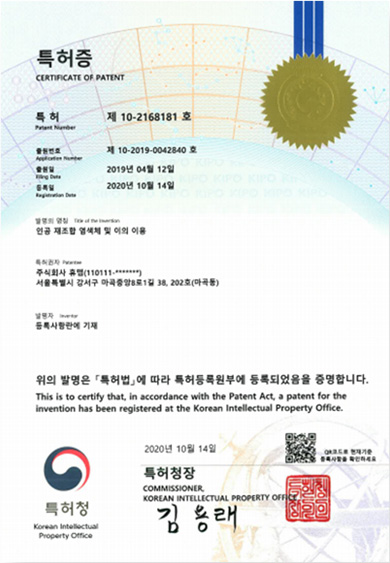
TECHNOLOGY
- AiCE®
- Artificial inter-species Chromosome Exchange (AiCE)
HuMab’s Proprietary Genome Engineering Technology
Introduction: AiCE® Technology

Accuracy
Chromosome-level replacement and insertion of whole human genes at the exact Ig loci

Time-saving
Over 2-Mb gene insertion per one chromosome-level replacement
Comparison with BAC technology
| BAC-based | AiCE® | ||
|---|---|---|---|
| Inserted DNA size (per each insertion) |
100kb ~ 150kb | >2Mb | Minimization of Knock-In process |
| Frequency of gene insertion * | >10 times for a complete gene exchange | 1 time | |
| Development time * | 10 years | Approx. 2 years | Shortening the development process |
* in case of BCR genes
Applications
- 01
Antibody Therapeutics
- 02
Cell Therapy
- 03
Organ transplantation
The conventional BAC technology inserts large numbers of human Ig gene fragments into the appropriate target animal gene loci one by one. Since the current DNA insertion technology allows only 100-150kb insertion at a time, dozens of repeated processes are required to complete 4Mb of human antibody gene transplanting, demanding a significant amount of time and cost.
HuMab’s AiCE® (Artificial Interspecies chromosome exchange) technology intends to induce chromosome-level replacement by planting the DNA sequences that recombinase recognizes onto the both ends of each gene to be inserted into mouse chromosome. As a first step of this process, the recombination sequence is inserted into the both ends of a target gene.
The next step is Microcell-Mediated Chromosome Transfer (MMCT), inducing microcells from human donor cells to fuse with mouse cells. The final step is to induce recombination protein expression in the fused cell to encourage one-to-one replacement between human and mouse chromosome.
AiCE® technology not only addresses the limitations of gene replacement (size, time, and cost) the existing technology had, but also holds the significance in that it has the technical scalability and flexibility as it can effectively replace the entire genome in a relatively short period of development time.
Patent
-

-
Artificial recombinant chromosome and the use thereof
Technology AiCE®/SynThese™ Filed KR, PCT, US(3), EP, CN, JP, AU, Others (7) Registered KR

